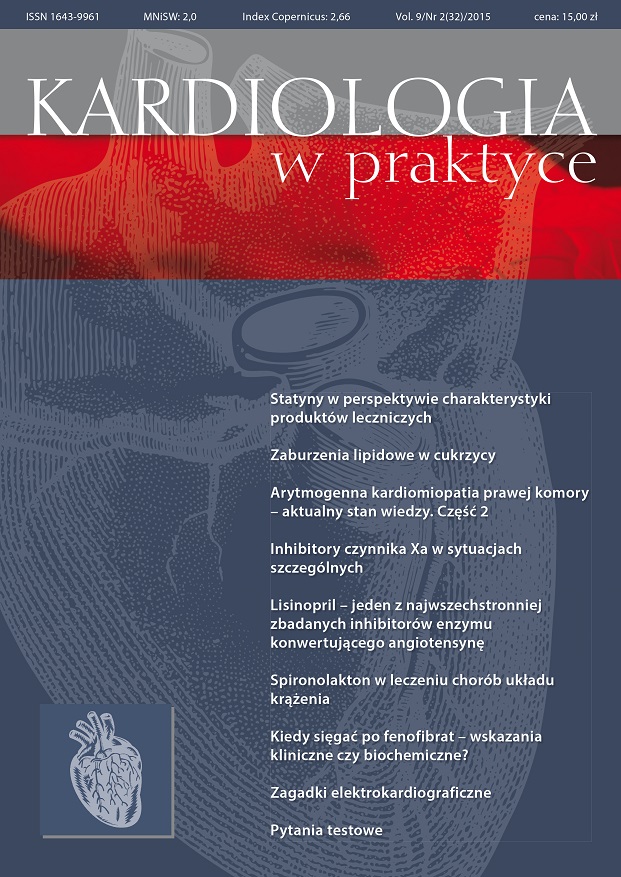Zaburzenia lipidowe w cukrzycy Artykuł przeglądowy
##plugins.themes.bootstrap3.article.main##
Abstrakt
Choroby sercowo-naczyniowe stanowią główną przyczynę wysokiej śmiertelności wśród chorych na cukrzycę, zwłaszcza typu 2. Jednym z najistotniejszych czynników ryzyka miażdżycy, a w konsekwencji chorób sercowo-naczyniowych w tej grupie pacjentów jest dyslipidemia aterogenna. Charakterystyczny profil zaburzeń lipidowych w cukrzycy cechuje się niskim stężeniem frakcji HDL cholesterolu, hipertriglicerydemią, przedłużoną poposiłkową lipemią oraz obecnością małych, gęstych cząsteczek LDL i HDL, które łatwo ulegają oksydacji i glikacji. W celu redukcji niekorzystnych powikłań sercowo-naczyniowych konieczne są wczesna diagnostyka oraz kompleksowe niefarmakologiczne i farmakologiczne leczenie wszystkich odchyleń parametrów lipidowych.
Pobrania
##plugins.themes.bootstrap3.article.details##

Utwór dostępny jest na licencji Creative Commons Uznanie autorstwa – Użycie niekomercyjne 4.0 Międzynarodowe.
Copyright: © Medical Education sp. z o.o. This is an Open Access article distributed under the terms of the Attribution-NonCommercial 4.0 International (CC BY-NC 4.0). License (https://creativecommons.org/licenses/by-nc/4.0/), allowing third parties to copy and redistribute the material in any medium or format and to remix, transform, and build upon the material, provided the original work is properly cited and states its license.
Address reprint requests to: Medical Education, Marcin Kuźma (marcin.kuzma@mededu.pl)
Bibliografia
2. Weitzman S., Wang C., Rosamond W.D. et al.: Is diabetes an independent risk factor for mortality after myocardial infarction? The ARIC (Atherosclerosis Risk in Communities) Surveillance Study. Acta Diabetol. 2004; 41: 77-83.
3. Howard B.V., Cowan L.D., Go O. et al.: Adverse effects of diabetes on multiple cardiovascular disease risk factors in women. The Strong Heart Study. Diabetes Care 1998; 21(8): 1258-1265.
4. Wilson P.W., Kannel W.B., Anderson K.M.: Lipids, glucose intolerance and vascular disease: the Framingham Study. Monogr. Atheroscler. 1985; 13: 1-11.
5. Zozulińska D.: Aterogenna dyslipidemia w cukrzycy typu 2. Kardiol. Pol. 2006; 64: 10(supl. 6): S567-S571.
6. Cohn J.S., Patterson B.W., Uffelman K.D. et al.: Rate of production of plasma and very-low-density lipoprotein (VLDL) apolipoprotein C-III is strongly related to the concentration and level of production of VLDL triglyceride in male subjects with different body weights and levels of insulin sensitivity. J. Clin. Endocrinol. Metab. 2004; 89(8): 3949-3955.
7. Carlson L.A.: Dyslipidemia cukrzycowa. Wyd. pol. pod red. D. Moczulskiego. Medycyna po Dyplomie 2009; 8(24).
8. Zasady leczenia dyslipidemii. Stanowisko Polskiego Towarzystwa Diabetologicznego. Zalecenia kliniczne dotyczące postępowania u chorych na cukrzycę 2015. Diabetologia Kliniczna 2015; 4(supl. A): A22-A24.
9. Dyslipidemia/Lipid Management American Diabetes Association. Standards of Medical Care in Diabetes 2015. Diabetes Care 2015; 38(supl. 1): S51-S54.
10. Turner R.C., Millns H., Neil H.A.W. et al.: Risk factors for coronary artery disease in non-insulin dependent diabetes mellitus: United Kingdom prospective diabetes study. BMJ 1998; 316: 823-828.
11. Collins R., Armitage J., Parish S. et al.; Heart Protection Study Collaborative Group: MRC/BHF Heart Protection Study of cholesterol-lowering with simvastatin in 5963 people with diabetes: a randomised placebo-controlled trial. Lancet 2003; 361(9374): 2005-2016.
12. Colhoun H.M., Betteridge D.J., Durrington P.N. et al.: CARDS Investigators. Primary prevention of cardiovascular disease with atorvastatin in type 2 diabetes in the Collaborative Atorvastatin Diabetes Study (CARDS): multicentre randomized placebo-controlled trial. Lancet 2004; 364(9435): 685-696.
13. Grzeszczak W., Gumprecht J.: Zaburzenia lipidowe występujące u chorych na cukrzycę – znaczenie badania CARDS. Diabetologia Doświadczalna i Kliniczna 2005; 5(1): 29-35.
14. Shepherd J., Barter P., Carmena R. et al.: Effect of lowering LDL cholesterol substantially below currently recommended levels in patients with coronary heart disease and diabetes: the Treating to New Targets (TNT) study. Diabetes Care 2006; 29(6): 1220-1226.
15. Cannon C.P., Braunwald E., McCabe C.H et al.: Pravastatin or Atorvastatin Evaluation and Infection Therapy-Thrombolysis in Myocardial Infarction 22 Investigators. Intensive versus moderate lipid lowering with statins after acute coronary syndromes. N. Engl. J. Med. 2004; 350(15): 1495-1504.
16. Ergou S., Lee C.C., Adler A.I.: Statins and glycaemic control in individuals with diabetes: a systematic review and meta-analysis. Diabetologia 2014; 57: 2444-2452.
17. Sattar N., Preiss D., Murray H.M. et al.: Statins and risk of incident diabetes: a collaborative meta-analysis of randomized statin trials. Lancet 2010; 375(9716): 735-742.
18. Ginsberg H.N., Elam M.B., Lovato L.C. et al.; ACCORD Study Group: Effects of combination lipid therapy in type 2 diabetes mellitus. N. Engl. J. Med. 2010; 362(17): 1563-1574.
19. Rubins H.B., Robins S.J., Collins D. et al.: Gemfibrozil for the secondary prevention of coronary heart disease in men with low levels of high-density lipoprotein cholesterol. Veterans Affairs High-Density Lipoprotein Cholesterol Intervention Trial Study Group. N. Engl. J. Med. 1999; 341(6): 410-418.
20. Keech A., Simes R.J., Barter P. et al.; FIELD Study Investigators: Effects of long-term fenofibrate therapy on cardiovascular events in 9795 people with type 2 diabetes mellitus (the FIELD study): randomised controlled trial. Lancet 2005; 366(9500): 1849-1861.
21. Ballantyne C.M., Olsson A.G., Cook T.J. et al.: Influence of low hihg-density lipoprotein cholesterol and elevated triglyceride on coronary heart disease events and response to simvastatin therapy in 4S. Circulation 2001; 104: 3046-3051.
22. Miselli M.A., Nora E.D., Passaro A. et al.: Plasma triglycerides predict ten-years all-cause mortality in outpatients with type 2 diabetes mellitus: a longitudinal observational study. Cardiovasc. Diabetol. 2014; 13: 135.
